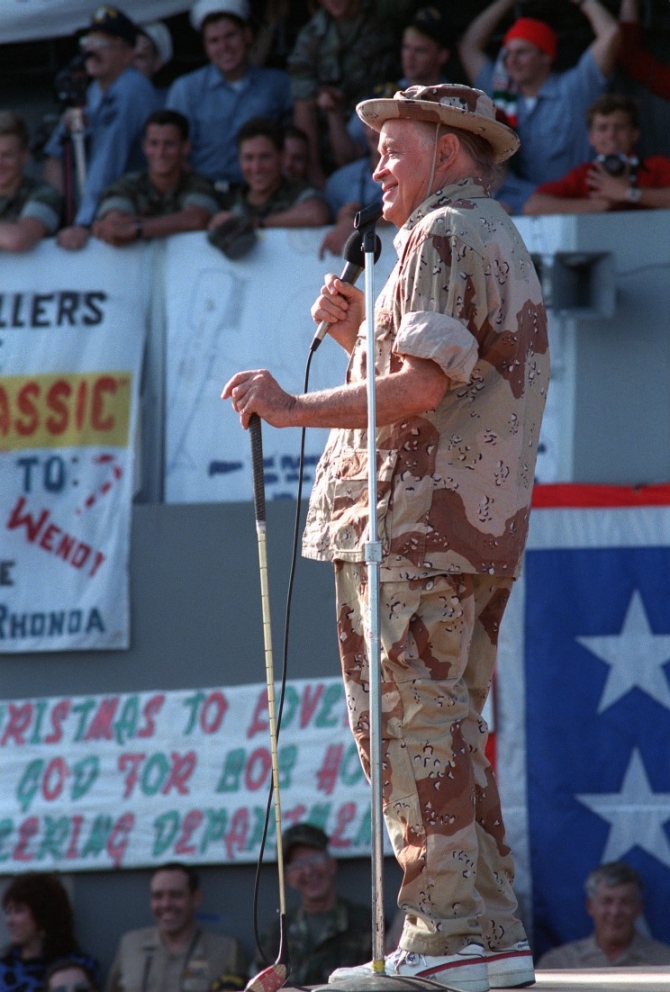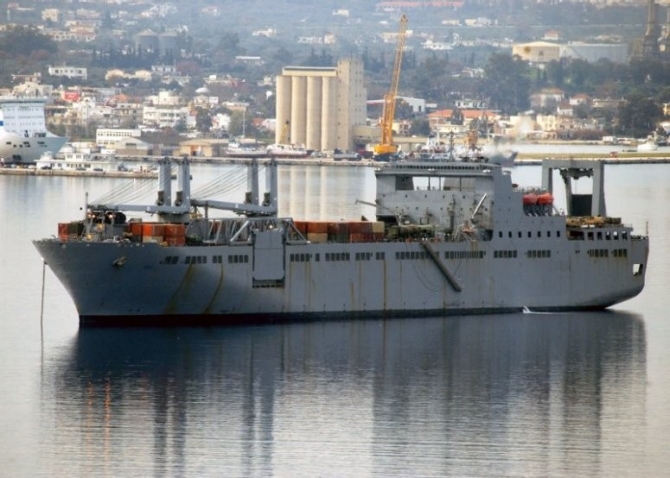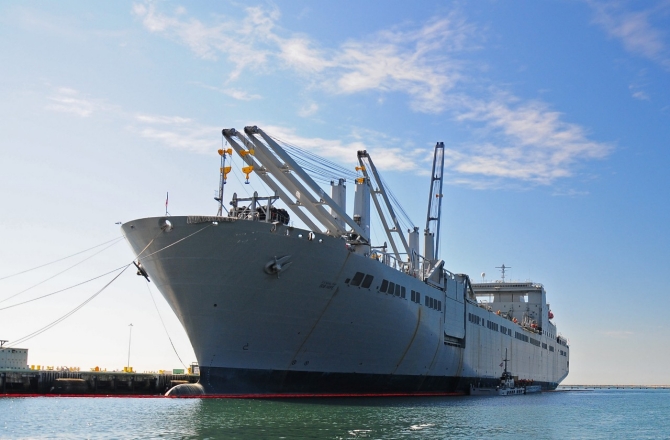Bob Hope (T-AKR-300)
1997–
U.S. Navy ship named in honor of comedian Bob Hope for his more than 50 years of support of U.S. forces stationed around the world.

Bob Hope was born Leslie Townes Hope on 29 May 1903 in Eltham, London, England and became a prominent figure in American comedy for decades. He spent his first years in England, where his father worked as a stonemason. In 1908 the family immigrated to the United States and settled in Cleveland, Ohio. Hope’s large family, which included six brothers, struggled financially in his younger years, therefore he worked a number of jobs ranging from soda jerk to shoe salesman in order to help ease his parents' financial strain.
Hope's mother, an aspiring singer at one time, shared her expertise with him. He also took dancing lessons and developed an act with his girlfriend as a teenager and the pair played local vaudeville theaters for a time. Afterwards, he partnered up with Lloyd Durbin for a two-man dance routine and later joined forces with George Byrne. Hope and Byrne landed some work with film star Fatty Arbuckle and they made it to Broadway in Sidewalks of New York in 1927.
By the early 1930s, Hope began a solo act. He attracted widespread notice for his role in the Broadway musical Roberta which showcased his quick wit and comic timing. During the production, Hope met co-star and singer Dolores Reade and the pair married in February 1934. Hope once again showed off his comedic talents in the Ziegfeld Follies of 1936 and later that year, he landed a leading part in Red, Hot and Blue, with Ethel Merman and Jimmy Durante.
In 1937, Hope received his first radio contract. He began his own show the following year, which became a regular feature on Tuesday nights. Week after week, listeners tuned in to hear Hope's one-liners and wisecracks. He became one of radio's most popular performers and continued on the air until the mid-1950s.
In the late 1930s, Hope made the transition to feature films. His first major role came in The Big Broadcast of 1938, in which he sang "Thanks for the Memory" with Shirley Ross. The song became his trademark tune. The following year, Hope starred in The Cat and the Canary, a hit comedic mystery.
In 1940, Hope made his first film with popular singer Bing Crosby. The pair starred together as a pair of likeable con artists in The Road to Singapore with Dorothy Lamour playing their love interest. The duo became a box office success and Hope and Crosby made six additional Road pictures together.
On his own and with Crosby, Hope starred in numerous hit comedies. He was one of the top film stars throughout the 1940s, with such hits as 1947's western spoof The Paleface. He was also often called upon to use his ad-lib skills as the host of Academy Awards. While he never won an Academy Award for his acting, he received several honors from the Academy of Motion Picture Arts and Sciences over the years.
In the 1950s, Hope enjoyed a new wave of success on the small screen. He starred in his first television special on NBC in 1950. His periodic specials became a long-standing feature on the network, managing to earn impressive ratings with each new show over a 40-year time span. Nominated several times over the years, Hope won an Emmy Award in 1966 for one of his Christmas specials.
Hope was on board RMS Queen Mary when Germany invaded Poland on 1 September 1939 and he volunteered to perform a special show for the passengers, during which he sang "Thanks for the Memory" with rewritten lyrics. He performed his first United Service Organizations (USO) show on 6 May 1941 at March Field, Ca. and continued to travel and entertain troops for the rest of World War II, the Korean War, the Vietnam War, the third phase of the Lebanon Civil War, the latter years of the Iran-Iraq War, and the 1990-91 Persian Gulf War. His USO career lasted 50 years during which he headlined 57 tours. He had a deep respect for the men and women who served in the military and this was reflected in his willingness to go anywhere in order to entertain them.
For his service to his country through the USO, he was awarded the Sylvanus Thayer Award by the United States Military Academy at West Point in 1968. Also a 1997 act of Congress signed by President Bill Clinton named Hope an “Honorary Veteran”. He remarked, “I've been given many awards in my lifetime, but to be numbered among the men and women I admire most is the greatest honor I have ever received”.
By the late 1990s, Hope had become one of the most honored performers in entertainment history. He received more than 50 honorary degrees in his lifetime as well as a Lifetime Achievement Award from the Kennedy Center in 1985, a Medal of the Arts from President Bill Clinton in 1995 and a British knighthood in 1998.
Bob Hope passed away at his home on 27 July 2003. He is interred at San Fernando Mission Cemetery in Los Angeles, Ca.
(T-AKR-300: displacement 62,644; length 950'; beam 106'; draft 35'; speed 24 knots; complement 26 civilian (up to 45) up to 50 active duty; class Bob Hope)
Bob Hope, was laid down on 29 May 1995 at New Orleans, La., by Avondale Shipyard, Inc.; launched on 27 March 1997; and sponsored by Mrs. Dolores Hope, wife of Bob Hope. She is the lead ship of the Bob Hope class of vehicle cargo ships and entered non-commissioned U.S. Navy service with the Military Sealift Command (MSC) with a primarily civilian crew on 18 November 1998. A non-combatant roll-on/roll-off (RORO) vessel, Bob Hope and other ships of her class are used to preposition tanks, trucks, various wheeled vehicles and supplies needed to support an army heavy brigade.

From 4-8 March 2013, Naval Beach Group (NBG) 1, 1st Marine Logistics Group, Amphibious Construction Battalion (ACB) 1 and Bob Hope collaborated during training exercise Brilliant Scepter. The exercise displayed the Navy’s ability to perform at sea loading operations for the various vehicles, equipment and units of the armed services without the need of amphibious ships coming ashore. Brilliant Scepter provided realistic and relevant training such that naval units deploy from a ship to build a functional camp for a Marine or an Army presence. This capability allows U.S. military units to provide a quick amphibious response in the event of a crisis or humanitarian assistance and disaster relief event.

Detailed history pending.
Paul J. Marcello
11 December 2015


